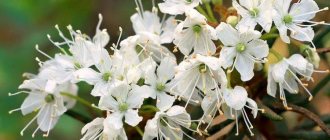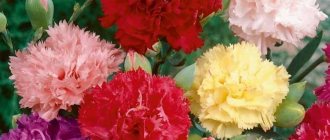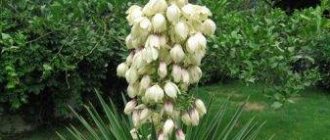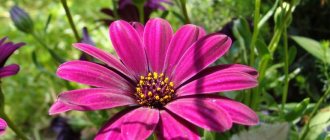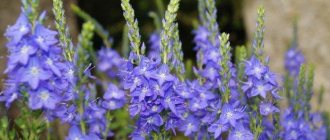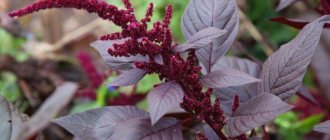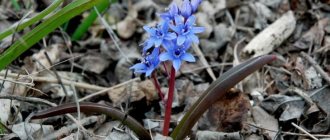- October 19, 2018
- Wild plants
- Svetlana Pavlova
Ledum is a shrub with evergreen foliage that emits a strong aroma during flowering, causing headaches and nervous disorders in humans. This plant is mysterious and paradoxical. Where does wild rosemary grow? It grows in swamps but is drought tolerant. Ledum has narrow leaves to save moisture, despite the fact that the roots are in water. The fact is that once its ancestors grew in Africa, and the plant retained external characteristics characteristic of the flora of a distant sunny continent, while it itself moved to the northern and swampy regions.
Description, features
The height of a bush in adulthood depends on the conditions in which it grew. The range ranges from 15 to 130 cm. Some specimens grow five meters tall, but this is rare. The length of the highly branched roots is approximately ten meters. The dark green leaves are evenly spaced, with their edges curling upward. On the underside of the leaf blades there is a reddish-brown fluff. There are also glands containing essential oil substances. The stems are recumbent, with many ascending branches.
The shrub is very beautiful, but poisonous. In beauty it can be compared with Japanese sakura. Flowers are white or pink. They are dense, five-leafed, located on thin stalks. They bloom in late spring and are good honey plants. However, it should be remembered that collected honey is also poisonous and is suitable for consumption only by the bees themselves.
During the flowering period, esters are released into the air in high concentrations. They are harmful to animals and people because they contain poison that affects the nervous system. After even a short stay near a blooming wild rosemary, characteristic symptoms of poisoning appear. Among them:
- nausea;
- vomit;
- weakness;
- headache;
- dizziness;
- loss of consciousness.
Animals prefer to avoid areas where the plant is located. But sometimes cases of poisoning happen to them too. Most often, hunting dogs become victims.
The fruits are multi-seeded capsules with five nests. Winged seeds are very small in size. Their ripening occurs in the second half of summer.
Precautionary measures
As already mentioned, the toxic substances contained in wild rosemary can negatively affect human health. Essential oils are released especially intensely during flowering. If you stay near a flowering plant for a long time, dizziness, nausea, headache and even paralysis of the limbs occur. Exceeding the dosage of wild rosemary preparations leads to severe poisoning, vasospasm, disruption of the gastrointestinal mucosa, and respiratory failure. People suffering from:
- hypertension;
- kidney and liver diseases;
- disorders of the autonomic system.
Pregnant and lactating women are advised to avoid flowering wild rosemary bushes. And for those who drive a car, it is better not to drive after taking medications from wild rosemary. Without a doctor's recommendation, you should not use medications that contain this plant.
Landing
The shrub must grow and develop in suitable conditions. It does not like bright sunlight, so it is preferable to plant it in the shade. This is an oligotrophic plant that prefers poor and acidic soils. Some species are able to grow on depleted soil with a sandy structure. When selecting a site, you should take into account that this is a perennial that will not have to be replanted for a long time.
The best time to plant wild rosemary is spring. However, if the specimen has a closed root system, then the season does not matter much.
Recommendations:
- Each bush is placed in a pre-dug hole (to a depth of 40 to 50 cm).
- The pit must be filled with the mixture. Its composition: sand (or small pebbles), soil from under coniferous plants (or tree bark), peat.
- A certain interval between plants must be maintained - 50-70 cm.
- After planting, the bushes need to be mulched with pine needles or sawdust.
Harm and contraindications
You should not use wild rosemary if you have:
- pancreatitis;
- hepatitis;
- breastfeeding period;
- under 16 years of age;
- pregnancy;
- glomerulonephritis;
- individual intolerance.
If you notice the following side effects, consult your doctor immediately:
- poisoning;
- dizziness;
- irritability;
- nausea;
- clouding of mind.
Care
This is an unpretentious and cold-resistant plant. It needs: watering, fertilizing with fertilizers (with a mineral composition), loosening the soil, pruning.
To maintain optimal soil acidity, you need to water the wild rosemary with acidified water 2-3 times a month. Frequent watering is required during dry and hot periods. 5-8 liters of water should be poured under each bush.
No special pruning required. Only broken, diseased and dry branches should be removed.
It is necessary to loosen the soil very carefully so as not to harm the root system located too close to the surface.
For feeding use ammonium nitrate, urea or ammonium sulfate.
Morphological characteristics
The life form of marsh rosemary is an evergreen shrub, the height of which, as a rule, does not exceed 80 cm. The height of the bush depends not only on the climatic zone, but also on the microclimate and the place where it grows.
The shoots of the bush, spreading along the ground, take root, due to which wild rosemary spreads vegetatively. The color of the bark is gray, brown or gray-brown, adult shoots are bare, and young shoots are pubescent with short brown hairs. The roots penetrate 30-40 cm into the soil, the root system has many additional roots. Marsh wild rosemary is a pronounced mycotroph: plants that form mycorrhizae. Without symbiosis with the hyphae of soil fungi, the shrub practically does not grow and often dies.
The leaves are simple, lanceolate or oblong, green in color with short petioles. The upper surface of the leaf is shiny, with many glands, the lower surface with many light brown hairs. The arrangement of the leaves is opposite.
Flowers are on long stalks, collected in inflorescences of the corymb or umbrella type. The color of the flowers is snow-white, yellowish or reddish. The perianth is double, the calyx and corolla are five-membered, the upper ovary consists of five carpels. Flowers with a strong scent to attract pollinating insects. The smell can be so strong that it causes dizziness and nausea, which is why marsh rosemary is popularly called “swamp stupor.” The beginning of flowering depends on the climate zone (May - July).
The fruit of wild rosemary is a five-locular (according to the number of carpels) capsule with small flat seeds.
Reproduction
The shrub reproduces both by seeds and by vegetative means.
Seeds
In early spring, freshly collected seeds are sown in boxes on a substrate without deepening. Then cover the containers with glass (or film) and put them in a cool place. They must be ventilated every day and the glass must be wiped. Watering is carried out with water from a spray bottle. Seed germination occurs in about a month.
Vegetative methods (cuttings, bushes, layering)
Let's consider all three methods:
- Cuttings. The most complex procedure, which is rarely used because it requires knowledge and skills. Preparation of cuttings is carried out in the summer. The shoots are cut into small sizes ─ 6 cm in length. The lower leaves should be trimmed, leaving only the upper ones. In order to successfully root the cuttings, they are kept for a day in a heteroauxin solution, then washed and planted on the site. Rooting will occur only next spring.
- Bushes. Adult wild rosemary is divided into small seedlings and planted in open ground.
- Layerings. Thin branches must be tilted and rooted next to the mother bush (to a depth of at least twenty centimeters). The middle part is sprinkled with soil, and the inclined branch is partially placed in the hole.
Ledum – photo
Keep an even larger selection of photos to make it easier for you to identify wild rosemary and finally decide what you think about it!
Photo: nat-geo.ru
Photo: oir.mobi
Photo: drive2.ru
Photo: flo.discus-club.ru
Photo: mrfilin.com
Photo: poleznii-site.ru
Photo: uborka-v-dome.ru
Photo: plantarium.ru
Photo: fotoload.ru
Photo: domsvechei.ru
Photo: zhenskiye-sovety.ru
Photo: kustroz.ru
Photo: flo.discus-club.ru
Photo: nat-geo.ru
Photo: flower.onego.ru
Photo: na-dache.pro
Photo: svb28.ru
Photo: les.media
Photo: zen.yandex.ru
Photo: zen.yandex.by
Photo: zen.yandex.ru
Photo: blotos.ru
Photo: viplor.ru
Photo: distano.ru
Did you like the post? Subscribe to our channel in Yandex.Zen, it really helps us in our development!
Kinds
In total, there are about ten species of wild rosemary, four of which grow in our country. More details about them:
- Bolotny. The most famous species both in natural conditions and in culture. Prefers moderate climatic conditions. Grows in highlands, tundras, swampy soils, and permafrost areas. Its other names are forest rosemary, bug grass, gologolom, bagoong. The height of the compact bush ranges from 50-110 cm. The dark shiny leaves have pointed tips. Flower color is white or light pink.
- Large-leaved. Habitat: Japan, Korea and the Far Eastern region. The bush reaches a height of 1.5 meters. Places of growth: heather thickets, mountain coniferous forests, sphagnum bogs. The leaves are oval, covered with red hairs. The flowering period occurs in the first summer month. The plant is characterized by increased frost resistance.
- Greenlandic. Distributed throughout the Arctic zone. Favorite places to grow are peat bogs and wet coasts. It is distinguished by creeping and rigid stems. The inflorescences are spherical in shape and decorated with white flowers. The leaf blades are oblong, covered with numerous red-brown or white hairs, and fit tightly to each other. Flowering begins in June and continues throughout July. The species has high frost resistance. When individual shoots freeze, the overall decorativeness of the plant does not suffer. Rarely found in horticulture, mainly in botanical gardens.
- Creeping (prostrate). It received this name because of its small height - from 20 to 30 cm. This is the shortest growing species. Found in North America and the Far East. Habitat: sparse forests, tundra, swamps, hummocks, sandy hills, cedar forest. Small and white flowers are located on a corymbose inflorescence. There are never too many of them, so flowering is sparse. The shoots are equipped with thick, reddish-rusty hairs. The growth rate is extremely slow; it grows about one centimeter per year.
Where and how does it grow
This wild plant is located in different areas. It grows in North America, the Far East and Greenland. It can also be found in Belarus in wooded peatlands. Ledum is often found in most of the Northern Hemisphere.
Ledum grows (see photo of the plant below) together with soil fungi. These mushrooms even extend through the roots of wild rosemary. If we compare wild rosemary with other plants, we can highlight one significant advantage. Ledum grows independently from seeds, and does not need the help of other plants or particularly fertile soil.
Medicinal properties
All parts of the plant (except for the rhizome) are rich in essential oil, which is identified by its specific smell. Most medicinal products are based on this component. Also, in the above-ground parts there is also a whole complex of active substances that have a multifaceted effect on the body. These include:
- iceol (sesquiterpene alcohol);
- neomertillin (has an inulin-like effect);
- arbutin (antiseptic);
- tannins (pronounced hemostatic and astringent properties);
- bioflavonoids (have a positive effect on vascular tone).
Ledum contains enzymes, organic acids, vitamins and minerals in small quantities.
In folk medicine it is rightfully recognized as a universal medicine. Has the following medicinal properties:
- painkillers;
- anti-inflammatory;
- diuretic;
- disinfectants;
- sedative;
- anticonvulsants.
The plant is widely used in medical practice. It is used in the form of decoctions, infusions, alcohol tinctures, ointments, drops, oils.
For example, it helps with cough, as it relaxes the smooth muscle tissue of the bronchi, promotes abundant secretion and removal of sputum. And for fever, it has been used since ancient times as an effective diaphoretic.
There are many more diseases and pathological conditions for which wild rosemary is used. Here is the detailed list:
- bronchitis;
- laryngitis;
- acute respiratory viral infections;
- bronchial asthma;
- tuberculosis;
- gout;
- urinary tract diseases;
- arthritis and arthrosis;
- pneumonia;
- hypertonic disease;
- intestinal dysbiosis;
- spastic enterocolitis;
- rheumatism;
- eczema, furunculosis.
Research has proven that medicines based on this plant are not addictive. For this reason, doctors may prescribe them for a long period of time.
Nutritional value and chemical composition
The composition of wild rosemary includes:
- vitamin A;
- vitamin B;
- vitamin E;
- vitamin C;
- sodium;
- calcium;
- selenium;
- iron;
- silicon;
- zinc;
- manganese;
- cobalt;
- molybdenum;
- potassium;
- amino acids;
- organic acids;
- essential fatty acids;
- bioflavonoids;
- phytoncides.
Landscape design
The perennial grows well under trees and on rocky embankments. Landscape designers use it to create beautiful compositions near bodies of water (lakes, rivers). Looks good with decorative spruce trees, thujas and other small conifers.
It also looks very attractive in garden plots. Of course, you can’t plant it near your house or in places where people often stay. But you can use the bush as a hedge. It will destroy harmful bacteria in the air and repel annoying insects (mosquitoes and flies) from the area. Creeping species are suitable for decorating rock gardens and rocky gardens.
Cultivating wild rosemary is not at all difficult. If you plant it in the right place in accordance with all the requirements, then all that remains is to enjoy the unusual and luxurious flowering of the shrub.
Application
Medicines containing wild rosemary increase heart rate and suppress cough, and also dilate blood vessels (peripheral and coronary). In addition, wild rosemary acts as a good diuretic. However, the use of wild rosemary is not limited to medicine. It is used everywhere, both in everyday life and cooking, and as a means for weight loss. You will learn more about this below.
In cooking
Ledum has a pronounced spicy aroma, and is often called forest rosemary. Actually, in cooking it is used in much the same way. Breads and cakes are prepared with wild rosemary, which slowly deteriorate due to the composition of wild rosemary, and also have a tonic effect. They make jam with wild rosemary, and from the essential oils of rosemary they often brew beer and make vodka.
For children
It is not recommended to use the product in children. Infusion of shoots can be used from 18 years of age.
In medicine
Ledum juice is used as a remedy for bacteria. It is able to overcome viral diseases such as whooping cough or diphtheria, hemolytic streptococcus and luminous vibrio.
Ledum essential oil can reduce cramps, relieve inflammation, accelerate blood flow and relieve spasms. Ledum is used to make compresses for joints, and is also used for neuritis and myositis. Decoctions or tinctures help overcome headaches or diseases of the cardiovascular system, as well as asthma and bronchitis.
At home
For domestic purposes, the culture is used as an insecticide. With its help, it is possible to destroy flies and other insects. To do this, it is recommended to fumigate the room. Branches and leaves are placed in a closet. They help protect against moths.
In garden culture
The shrub is often planted in garden plots. Marsh wild rosemary is characterized by slow development. However, with proper care, the crop grows in heather gardens for more than 30 years. The shrub is able to survive the winter without shelter.
The crop can be propagated by seed, cuttings or root division. The advantage of the shrub is its undemandingness to the composition of the soil. The plant is able to develop normally even in poor soil. It can be planted in shady places.
In cosmetology
The culture is able to strengthen and tone the skin. That’s why cosmetologists often use it. This allows you to slow down the aging process. With systematic use, it will be possible to obtain a noticeable rejuvenating effect.
The restoration and rejuvenation of the epithelium is due to the presence of vitamin E, selenium and flavonoids. These components strengthen capillary walls, normalize lymph flow and improve nutrition of skin cells. The antibacterial effect of the herb helps to cope with dermatological pathologies.
To achieve good results, you need to make a decoction and soak a cotton pad in it. It is recommended to wipe your face with this product twice a day – morning and evening. If an allergy occurs, it is recommended to mix the decoction with water or completely abandon its use.
When losing weight
Since wild rosemary is a strong diuretic, it is used in this way to get rid of a few extra pounds and remove excess water. However, in this case, a decoction of wild rosemary works only to remove water from the body. In the future, wild rosemary can only worsen the health condition.
Indications for use in medicine
- Dysentery;
- Diabetes;
- Angina;
- Pneumonia;
- Whooping cough;
- Rickets;
- Enterocolitis;
- Acute or chronic forms of bronchitis;
- Laryngitis;
- Pulmonary tuberculosis;
- Furunculosis;
- Scabies;
- Chicken pox;
- Flu;
- Polyarthritis;
- Arthrosis of deforming type;
- Scrofula;
- Acute or chronic rhinitis;
- Rheumatism, gout and other joint diseases;
- Neurodermatitis;
- Eczema;
- Insect and arthropod bites;
- Lichens of bacterial and non-bacterial origin;
- Wounds, bruises, bruises, scratches and other skin damage.
